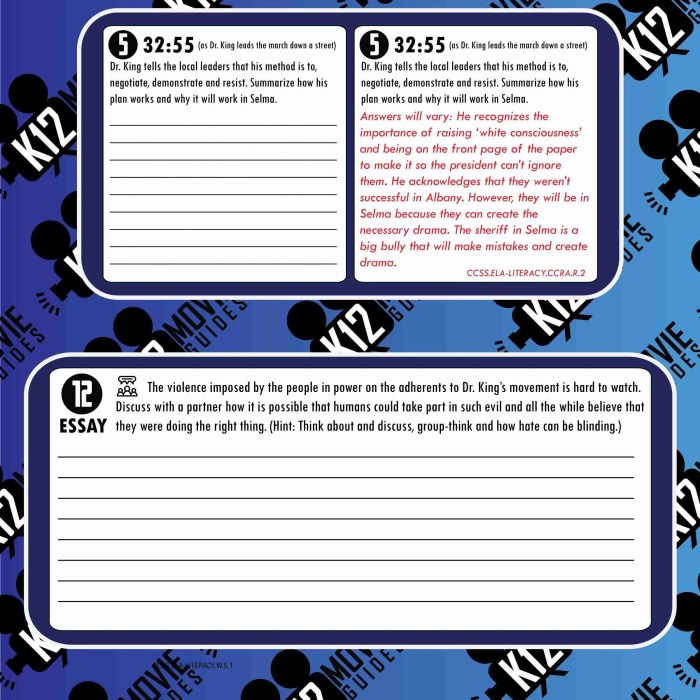Unveiling the depths of the acclaimed film Selma, our Selma Movie Guide Answer Key offers a captivating journey through its historical and cultural tapestry. Join us as we delve into the heart of the Civil Rights Movement, unraveling the complexities of its challenges and triumphs.
Through a comprehensive analysis of the film’s characters, symbolism, and filmmaking techniques, we’ll illuminate the profound impact of Selma on both American history and popular culture. Prepare to be captivated as we explore the legacy of this cinematic masterpiece.
Selma Movie Overview: Selma Movie Guide Answer Key
The film, set in 1965, chronicles the historic Selma to Montgomery marches led by Dr. Martin Luther King Jr. and the Southern Christian Leadership Conference (SCLC) to secure voting rights for African Americans in the United States. The film follows the events leading up to and during the marches, highlighting the nonviolent resistance employed by the civil rights activists in the face of police brutality and racial discrimination.
Main Characters
- Dr. Martin Luther King Jr.: The leader of the SCLC and the primary organizer of the Selma marches.
- Malcolm X: A prominent African American activist who advocated for self-defense and black nationalism.
- John Lewis: A young civil rights activist and future U.S. congressman who played a key role in the marches.
- Annie Lee Cooper: An elderly African American woman who was brutally attacked by police during the marches.
- Governor George Wallace: The segregationist governor of Alabama who opposed the marches and ordered state troopers to use violence against the protesters.
Historical Context

The film “Selma” depicts the historical events surrounding the Selma to Montgomery marches, which were pivotal moments in the American Civil Rights Movement.
The marches were organized by civil rights leaders, including Martin Luther King Jr., to protest the systemic disenfranchisement of African Americans in the South. The marches aimed to highlight the denial of voting rights and the need for federal intervention to protect the civil rights of African Americans.
Significance of the Selma to Montgomery Marches
The Selma to Montgomery marches had a profound impact on the Civil Rights Movement and American society as a whole.
- Increased National Attention:The marches drew national and international attention to the ongoing struggle for civil rights in the United States, putting pressure on the federal government to address the issue.
- Mobilization of Support:The marches mobilized support for the Civil Rights Movement, inspiring people across the country to join the fight for equality.
- Passage of the Voting Rights Act:The marches played a crucial role in the passage of the Voting Rights Act of 1965, which outlawed discriminatory practices that prevented African Americans from exercising their right to vote.
Civil Rights Movement

The Civil Rights Movement was a pivotal period in American history marked by nonviolent protests, activism, and legislative changes aimed at ending racial discrimination and achieving equal rights for African Americans. Key themes of the movement included:
- Ending racial segregation and discrimination in public facilities, education, and employment.
- Ensuring the right to vote for African Americans through the passage of the Voting Rights Act of 1965.
- Promoting economic equality and social justice.
Selmadepicts the challenges and triumphs of the movement through the lens of the Selma to Montgomery marches led by Dr. Martin Luther King Jr. in 1965. The film highlights the brutal police violence faced by peaceful protesters, the determination and resilience of activists, and the eventual passage of the Voting Rights Act.
The Challenges
The Civil Rights Movement faced numerous challenges, including:
- Racist attitudes and beliefs deeply ingrained in society.
- Violent resistance from white supremacists and segregationists.
- Government inaction and resistance to change.
Selmavividly portrays these challenges through scenes of police brutality, the bombing of a church, and the murder of activists.
The Triumphs
Despite the challenges, the Civil Rights Movement achieved significant triumphs, including:
- The desegregation of schools and public facilities.
- The passage of the Civil Rights Act of 1964, prohibiting discrimination based on race, color, religion, sex, or national origin.
- The Voting Rights Act of 1965, guaranteeing the right to vote for all Americans.
Selmacelebrates these triumphs by showing the power of nonviolent protest, the courage of activists, and the transformative impact of the movement.
Character Analysis
The film Selma presents a compelling cast of characters whose motivations, actions, and relationships drive the narrative forward and reflect the broader themes of the Civil Rights Movement.
Dr. Martin Luther King Jr.
As the central protagonist, Dr. King embodies the film’s core themes of nonviolent resistance and the pursuit of racial equality. His unwavering belief in the power of love and dialogue inspires his followers and challenges the oppressive forces that stand in their way.
Through his speeches and actions, King becomes a symbol of hope and determination for the Civil Rights Movement.
Malcolm X
Malcolm X represents a contrasting perspective within the Civil Rights Movement. His fiery rhetoric and advocacy for self-defense challenge King’s nonviolent approach. Malcolm X’s presence highlights the ideological tensions within the movement and raises questions about the best strategies for achieving social change.
Lyndon B. Johnson
President Lyndon B. Johnson plays a pivotal role in the film. Initially hesitant to support the Voting Rights Act, Johnson eventually comes to recognize its importance and uses his political power to ensure its passage. His journey reflects the complex political dynamics of the time and the challenges of balancing personal beliefs with political realities.
Annie Lee Cooper
Annie Lee Cooper is a young woman whose attempt to register to vote becomes a catalyst for the Selma march. Her courage and determination in the face of intimidation and violence embody the indomitable spirit of the Civil Rights Movement.
Jim Clark, Selma movie guide answer key
Jim Clark, the sheriff of Dallas County, represents the violent opposition to the Civil Rights Movement. His brutality and unwavering commitment to segregation serve as a stark reminder of the systemic racism that African Americans faced during this period.
Symbolism and Imagery
Selmaemploys a range of powerful symbols and imagery to convey its message about the Civil Rights Movement and the ongoing struggle for racial justice. These elements serve as visual metaphors, enhancing the film’s emotional impact and underscoring its historical significance.
One prominent symbol in the film is the Edmund Pettus Bridge. The bridge becomes a focal point of the Selma to Montgomery marches, representing the physical and symbolic barriers faced by civil rights activists. Its crossing symbolizes the determination and courage of the marchers, as well as the obstacles they overcame in their quest for equality.
Color Symbolism
The film also uses color symbolism to convey emotional and thematic undertones. The use of black and white in certain scenes evokes a sense of historical documentation, while the vibrant colors during the marches represent the energy and hope of the movement.
The contrast between these elements highlights the struggle between the forces of oppression and the aspirations of the civil rights activists.
If you’re looking for a comprehensive guide to the powerful Selma movie, check out the answer key. To delve deeper into the legal aspects of civil rights, you can also explore Joshua’s Law Unit 7 Lesson 3 , which provides valuable insights.
Returning to the Selma movie guide answer key, it offers detailed explanations and analysis to enhance your understanding of the film’s historical significance.
Water Imagery
Water imagery is another significant element in Selma. The crossing of the Alabama River during the Selma to Montgomery marches symbolizes the baptism of the civil rights movement. Water also represents the cleansing and renewal associated with the movement’s transformative power.
Religious Symbolism
Religious symbolism is interwoven throughout the film, reflecting the deep spiritual roots of the Civil Rights Movement. The use of gospel music, prayers, and biblical references evokes a sense of communal strength and the belief in a higher power guiding the activists’ struggle.
Film Techniques

The film Selma effectively utilizes cinematography, editing, and sound design to enhance its emotional impact and historical authenticity. CinematographyThe film’s cinematography captures the raw emotions and struggles of the civil rights movement. The use of handheld cameras creates a sense of immediacy and authenticity, immersing the viewer in the events unfolding on screen.
Long, sweeping shots capture the vast crowds and the sheer scale of the movement. EditingThe film’s editing seamlessly transitions between historical footage and dramatized scenes, blurring the line between past and present. This technique evokes a sense of urgency and connects the viewer to the ongoing fight for equality.
The use of flashbacks and intercutting heightens the emotional impact, providing a deeper understanding of the characters’ motivations and the historical context. Sound DesignThe film’s sound design is equally evocative. The soundtrack features powerful spirituals and protest songs, which amplify the emotions and convey the spirit of the movement.
The use of silence in key moments creates a palpable tension, allowing the viewer to fully absorb the weight of the events unfolding.
Cultural Impact
The film Selma has had a profound impact on popular culture and the broader public. It has helped to raise awareness of the Civil Rights Movement and its significance in American history.
The film has also been praised for its accurate portrayal of the events in Selma and its depiction of the courage and determination of the civil rights activists who fought for voting rights.
Influencing Perceptions
The film has influenced perceptions of the Civil Rights Movement in several ways. First, it has helped to humanize the movement by showing the personal stories of the people who were involved.
Second, it has helped to highlight the role of nonviolent resistance in the movement. Third, it has helped to show the importance of the Voting Rights Act of 1965 in securing voting rights for African Americans.
Legacy and Historical Significance
Selma’s impact on American history and society has been profound, leaving a lasting legacy of understanding and reconciliation.
The film’s unflinching portrayal of the events surrounding the Selma to Montgomery marches ignited a national conversation about race and the ongoing struggle for civil rights. It shed light on the brutality and injustice faced by African Americans during the era and prompted a reevaluation of the nation’s history.
Promoting Understanding and Reconciliation
Selma’s impact extends beyond raising awareness. It has played a pivotal role in fostering understanding and reconciliation between different segments of society.
- Bridging the Racial Divide:By showcasing the experiences and perspectives of both white and black Americans, the film helped break down stereotypes and promote empathy.
- Historical Healing:Selma’s portrayal of the events leading up to the Voting Rights Act of 1965 has contributed to a more nuanced understanding of the civil rights movement, facilitating a process of historical healing.
- Continuing Dialogue:The film has sparked ongoing discussions about race, inequality, and the need for continued progress. It has served as a catalyst for conversations that were previously difficult or avoided.
Questions and Answers
What is the significance of the Selma to Montgomery marches?
The Selma to Montgomery marches were pivotal in the Civil Rights Movement, highlighting the struggle for voting rights and galvanizing national support for the cause.
How does the film depict the challenges faced by the Civil Rights Movement?
Selma portrays the violence, arrests, and legal obstacles that activists encountered while fighting for equality.
What are the key themes explored in the film?
Selma examines themes of racial injustice, nonviolent resistance, and the power of collective action.